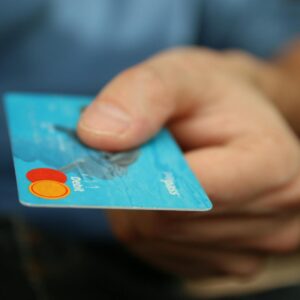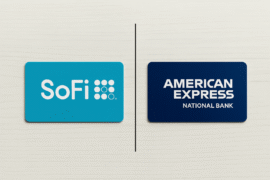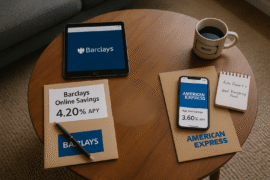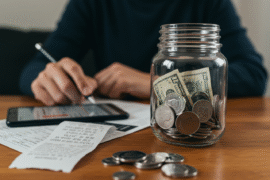This article may contain references to products or services from one or more of our advertisers or partners. We may receive compensation when you click on links to those products or services. Nonetheless, our opinions are our own.
- Fashion Debt in the United States
- Common Causes of Fashion Debt
- Recognizing Signs of Overspending
- The Cost of Chasing Trends
- How Fast Fashion Affects Your Finances
- Psychological Triggers That Drive Fashion Spending
- Steps to Overcome Fashion Debt
- What You Need to Get Started
- Ways to Regain Financial Control
- Final Thoughts on Overcoming Fashion Debt
- Frequently Asked Questions
- Recommended Reads
Fashion Debt in the United States
Fashion debt is more common than many people think. It happens when people keep buying clothes and other fashion items, spending more than what they earn. Reports show that people often spend a lot on clothes and this can put stress on their money and how they manage their budgets.
This debt does not come only from buying fancy things. Stores that sell cheap, fast fashion also make people spend too much money. They do this by always having new items and lots of sales.
The problem gets worse in cities where it costs a lot to live, like New York or Los Angeles. Sales and discounts that come up during some times of the year can make people buy things on a whim. A lot of the time, they buy stuff they do not need. To start dealing with debt in a good way, people need to see how their way of living and how they shop go together.
Common Causes of Fashion Debt
Living in busy city areas means you see more places to shop. This can make it easy to get into debt. People feel pressure from others to wear the same styles and buy new things. Many people feel like they have to keep up, so they often buy things quickly without much thought.
Poor money planning is another big reason. Many people spend without thinking about what they earn or their budget. This gets worse when there is a lot of strong advertising that tries to make you feel like you need things you really do not. When people choose wants over stuff they really need, it leads to more debt problems.
Emotions can have a big impact. Some people go shopping when they feel stressed or sad. They feel a bit better at first, but this way to feel good does not last long. In the end, it can make money problems even worse.
Recognizing Signs of Overspending
Finding out if you spend too much money can be hard. A sign to watch for is when you feel afraid to look at your bank or paycheck papers. This fear often shows up when you feel that the amount you spend does not match what you make.
Additional signs include:
- Maxed-out credit cards because of quick shopping decisions.
- Feeling regret or sadness right after going shopping.
- Going back often to return or exchange what you buy because you are not happy with it.
Seeing these patterns shows us that we need to look at our priorities again. It’s important to make better choices with our money and create healthier spending habits.
The Cost of Chasing Trends
Always buying new clothes to stay in style brings more than just money problems. It also adds stress and worry. A sale for the season may make you feel like you are saving money, but you might end up spending too much. These discounted things often bring more money troubles later.
To break this cycle, you need to know the real reasons you shop. When you change your spending habits and start thinking less about trends and more about your long-term goals, you help your money stay in better shape for a long time.
How Fast Fashion Affects Your Finances
Fast fashion looks cheap at first, but it can bring money problems over time. Big sales make people want to buy too much, so they use up their extra cash. This can make them get into debt. While picking up new things may feel good right then, many wish they had not bought these things when some time has passed.
When people try to keep up with all the latest trends, they often spend more money. This happens without thinking much about saving or long-term value. Here are some ways fast fashion can hurt your money:
| Impact Type | Description |
|---|---|
| Hidden Costs | Frequent small purchases that accumulate over time. |
| Mental Toll | Unpaid bills are causing ongoing stress. |
| Depreciation | Clothing items rapidly lose value after purchase. |
Building good spending habits and planning ahead can help you avoid buying things you do not need. This will help you keep your money safe and healthy.
Psychological Triggers That Drive Fashion Spending
Psychological triggers, like marketing tricks and feelings, play a big part in how people shop. The emails and ads that are sent just for you can make you buy things quickly without planning. This happens even more around payday, when it feels good to spend.
Feelings we have can make these triggers feel stronger. A lot of people try to feel better fast by shopping. They hope to get rid of stress or not feel bad about themselves. But this good feeling does not last long. It does not fix the problems and can make people owe more money.
Knowing these triggers helps people to make better choices. Thinking about why you want new things can help as well. Try to see less strong marketing by, for example, leaving promotional email lists. This can help you spend in a better way.
Steps to Overcome Fashion Debt
Getting out of fashion debt means you need to build good shopping habits and think again about what matters most. Keeping track of every dollar you spend helps you see where your money goes. This will help you notice your own spending habits and choices.
Progress happens from small changes, not big ones. Setting a budget each month that fits what you earn is a good start. It helps you have money limits you can keep up with. This also helps you get good at handling your money in the right way.
What You Need to Get Started
Getting back on track with money means you need ways to keep an eye on your spending and what you earn. Budgeting apps can help with this. Support from friends or family can give you the push you need and help you stay on track. To make a change that lasts, you need to be clear about your goals and try to stay hopeful about the future. This kind of thinking can help you stick with it over time.
Ways to Regain Financial Control
Getting your money back on track starts with small, easy steps:
Assess Current Fashion Spending
Look over what you have bought before and check your receipts. This will help you see how much you spend on clothes. Add up what you spend over a year and then work out the amount you spend each month so you can know what you really use on clothes.
Set Realistic Budgets and Limits
Set a monthly spending limit that matches what you earn and what you need to pay first. A good budget stops you from buying without thinking and helps you to shop wisely.
Shop Mindfully and Build a Sustainable Wardrobe
Pick clothes that you can wear in many ways and that last a long time. Try not to buy things just because you feel like it. Think about how well something fits with your other clothes and plan what you need. If you talk about your money goals with people you trust, it can help you make better choices.
Final Thoughts on Overcoming Fashion Debt
Understanding fashion debt helps people make better shopping choices. It also helps them get back control over their own money. When you focus on smart spending, use budget tools, and ask for support, you can start to feel better about where your money goes. Doing these things helps build a good base for strong money habits that last a long time. If you follow these steps, you can get out of debt. You will feel strong when you handle your money the right way.
Frequently Asked Questions
How can impulse buying in stores or online be stopped?
Making a strict budget and putting together a shopping list can help you not buy on a whim. Take time by waiting 24 hours before you buy something. This helps you think about if you really need it. Talking now and then with someone you trust about your spending can keep you on track and help build good habits with money.
Are there tools to track fashion spending and improve habits?
Yes, there are apps that help you keep track of how much money you spend on fashion. Apps like Mint, You Need a Budget, and Cladwell let you see your spending, set up budgets, and help you shop with care. These tools can be good for handling your money and help you pick clothes that are better for you in the long run.
Should expensive clothes be sold to pay debt?
Selling fancy clothes can help you lower what you owe. You should think about how much the clothes mean to you and how much money you can get from them. This will help you see if selling your items is the right choice for your money goals in the long run.
How long does it usually take to get out of fashion debt?
The time it takes can be different for each person. It depends on how much debt you have and how ready you are to change your shopping habits. Some people can be free of debt in several months. Others might need a few years. If you stick to a real and workable budget, you can reach your goal faster and feel better about your money.

Reviewed and edited by Albert Fang.
See a typo or want to suggest an edit/revision to the content? Use the contact us form to provide feedback.
At FangWallet, we value editorial integrity and open collaboration in curating quality content for readers to enjoy. Much appreciated for the assist.
Did you like our article and find it insightful? We encourage sharing the article link with family and friends to benefit as well - better yet, sharing on social media. Thank you for the support! 🍉
Article Title: Overcoming Fashion Debt: A Practical Guide
https://fangwallet.com/2025/07/07/overcoming-fashion-debt-a-practical-guide/The FangWallet Promise
FangWallet is an editorially independent resource - founded on breaking down challenging financial concepts for anyone to understand since 2014. While we adhere to editorial integrity, note that this post may contain references to products from our partners.
The FangWallet promise is always to have your best interest in mind and be transparent and honest about the financial picture.
Become an Insider

Subscribe to get a free daily budget planner printable to help get your money on track!
Make passive money the right way. No spam.
Editorial Disclaimer: The editorial content on this page is not provided by any of the companies mentioned. The opinions expressed here are the author's alone.
The content of this website is for informational purposes only and does not represent investment advice, or an offer or solicitation to buy or sell any security, investment, or product. Investors are encouraged to do their own due diligence, and, if necessary, consult professional advising before making any investment decisions. Investing involves a high degree of risk, and financial losses may occur including the potential loss of principal.
Source Citation References:
+ Inspo
There are no additional citations or references to note for this article at this time.












































